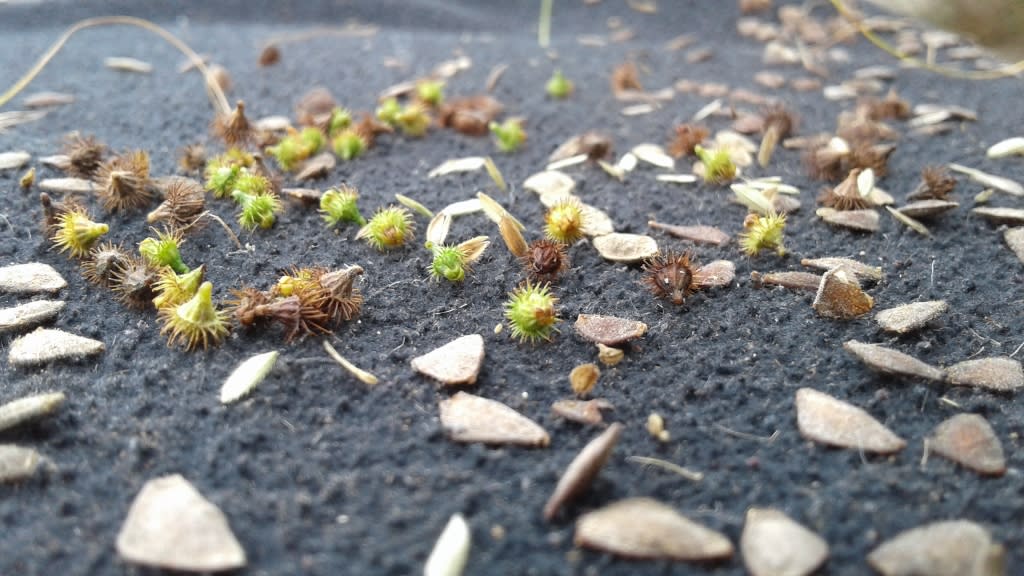There is nothing scary about an October walk through the prairies at Kankakee Sands . . . until you look down at your pants. Gasping in shock and horror, you realize that your pants are covered in seeds!
I admit it is a bit of a nightmare to find your clothing littered with a variety of seeds. And not just any seeds, but seeds that are extremely difficult to remove. As I write this article, a large pile of clothing sits beside my desk, clothing that is loaded with seeds and is waiting to be freed of nature’s adornments. Currently, on the very shirt that I am wearing are the seeds of sticktights, rice cut grass, and swamp agrimony. Interestingly, all of these species are native to Newton County, and oddly enough, we plant them intentionally into our prairie restorations.
Why such madness, you might ask? Well, it has to do with diversity and balance. Prairies are, by nature, botanically diverse ecosystems with a wide variety of flowers and grasses growing together across a large open space. The greater the diversity of plants, the greater the diversity of insect and animal life that can be supported, and thus the stronger the system. What’s more, your visit to Kankakee Sands is sure to be more interesting with so many plants, animals, and insects to see and experience.
Sticktights (Desmodium species) are in the bean family and have a lovely pink or purple flower in the same shape as all the members of the bean and pea family. We have eight species of sticktights that grow in our northwest Indiana area, such as Canada tick-trefoil and Illinois tick-trefoil. After the flowers of the sticktights are pollinated, seeds are formed. Each small smooth seed is surrounded by a ½ inch triangular shaped, grey-green pod with short hooked hairs that cover the surface of the pod. These hooked hairs allow the seedpod to attach to clothing and fur and to be transported to new and exciting places. And boy, does this plant ever stick tight?!
Sticktights are a wonderful food source for so many. Bumblebees nectar at the flowers; the larva of several moths and butterflies such as the eastern tail blue and grey hairstreak feed on the foliage; deer, quail, turkey, rabbits, and mice eat the seeds.
Swamp agrimony (Agrimonia parviflora) is aptly named, in my opinion, because it is indeed rather aggravating when the seeds stick to your clothing. These quarter-inch seeds, typically green or brown in color and conical, have hooked bristles that surround the rim of the seed. The hooked bristles grab onto clothing and fur with a vengeance. However, a variety of small native bees are attracted to agrimony’s flowers and the larva of several moths dine on its foliage.
Rice cut grass (Leersia oryzoides) not only has seeds that stick to clothing, but also has sharply serrated leaf blades, which, as you may guess from the name, causes cuts and scrapes on one’s skin. Harvesting the seed from this plant is a true battle, and you are often rewarded with a few battle scars to show for it. But it is all worth the effort when you consider that at least 15 species of birds are known to eat the seeds, including northern shovelers, blue-winged teal, sora rail, swamp sparrow, and tree sparrows. The tasty seeds are small, grey, five-millimeters long, and have stiff, short hairs along their edges which allow the seeds to attach to clothing and fur.
Seeds attach themselves to clothing and fur in a brilliant, effortless way in order to be transported to new locations where they can grow. Unfortunately for us humans, we have not yet found a brilliant, effortless way of removing the seeds from our clothing. Until we do, I’ll keep picking the seeds off, one by one, as I think about the many benefits of these clever plant species.
This Halloween, I was considering dressing up like a tick-trefoil or a rice cut grass seed. But I think I have decided against it. I’m afraid that it just might be too scary, giving even grown adults nightmares!
The Nature Conservancy’s Kankakee Sands is an 8,300-acre prairie and savanna habitat in Northwest Indiana, open every day of the year for public enjoyment. For more information about Kankakee Sands, visit www.nature.org/KankakeeSands.


